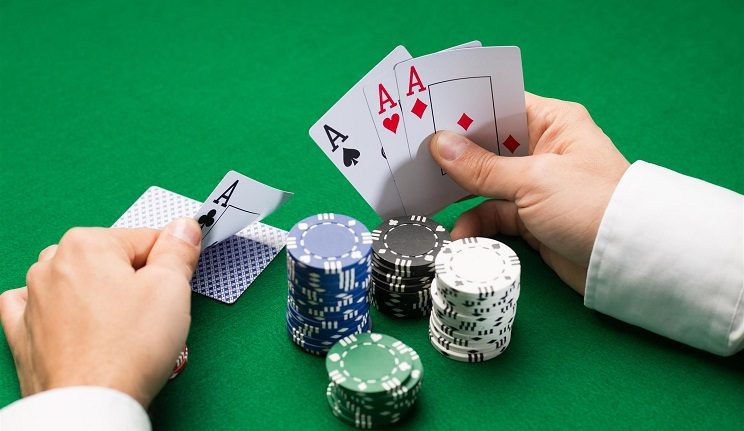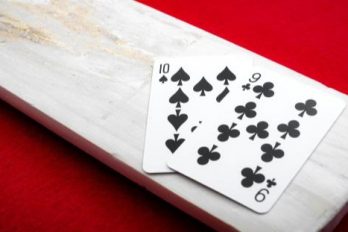How to Unmask a Poker Bluff
£200 Welcome Offer
£200 Welcome Offer

In the world of poker, gamblers spend years trying to master their poker face. When done correctly, a great poker face will scare away competitors and allow players to win almost every game. However, pok-er players need to consider more than just their face if they want to stay believable. When bluffing, most players have a few physical tells that give the game away. With this in mind, it’s possible to tell when a gambler is bluffing – you just need to know what to look for. In this article, we explore these signs in more detail and discuss exactly how to unmask a poker bluff.
Hand Gestures
Even if a gambler has their poker face down, their hands may be a giveaway. Research suggests that over 40% of liars use hand gestures when trying to convince their competitors, while only 20% of truth-tellers use excessive hand movement. If your opponent is talking, make sure to look at their hands. Are they using them more than usual? If you know your opponent, determining this may be easy. However, if you’re playing against a stranger it can be hard to work out. After all, they may always use their hands when they talk. If you’re unsure, look at the way they play their chips. Just like liars use excessive hand gestures, bluffers are more likely to fidget with their chips whilst they wait. When it comes to placing their chips on the table, truth-tellers will usually place them gently in the middle, while bluffers are more likely to toss them. Typically, this is to exhibit confidence and scare their opponent off. For those in the know, though, chip-tossing can be a clear-cut sign of a poker bluff.
Direct Eye-Contact
You may have heard the idea that liars avoid direct eye-contact. However, research has shown this to be untrue. In fact, liars are more likely to use direct eye-contact than truth-tellers, with the hope of convinc-ing you they’re telling the truth.
However, it’s not just bluffers that use direct eye-contact. Unfortunately, those telling the truth also look competitors directly in the eye 60% of the time, so I can be difficult to distinguish between somebody who is really telling the truth and somebody that’s just trying to make you think they are. However, re-search has shown that buffers use direct eye-contact 10% more often than truth-tellers. While truth-tellers look their opponent in the eye 60% of the time, bluffers use direct eye-contact for 70%. So when you’re at a poker table, keep your eyes peeled for direct eye-contact. If it seems excessive, you may have a bluffer on your hands.
Voicing Dissatisfaction
Generally, excessive strength is a sign of weakness – particularly amongst men. It’s no secret that the male population strive to appear tough. However, it’s physically impossible to be strong 100% of the time. To refrain from letting weakness show, many people make an extra effort to appear strong.
This idea can be used when playing poker. Generally, if a player seems over-confident, it’s likely that they’re bluffing. The same psychology can be used the opposite way, too. If your opponent is making an extra effort to look worried, they may be holding the winning cards. Research has shown that 30% of bluffers showed dissatisfaction during a poker game, while only 10% of truth-tellers voiced their concern. If your opponent appears to be worrying too much, they may be trying to trick you.
Head-Nodding
As mentioned in the previous tip, excessive strength can be a sign of weakness. When playing poker, look out for players who are constantly voicing their confidence. To scare off others players, gamblers often nod their head to show confidence. However, research has shown that the head-nodders are usually bluffing, while the stronger contestants remain still. Players with a good hand rarely need approval, while those that are losing try to convince their competitors otherwise.
Sentence Fillers
To unmask a poker bluff, look out for sentence fillers. Those using words like ‘erm’ and ‘er’ are more likely to be liars. Sentence fillers can indicate gaps in the thinking process where the liar is making things up as they go. This simple trick can be used at the poker table. To catch a bluffer, try asking your opponent di-rectly if they are bluffing. If they answer ‘erm, no’, they may be having you on. The use of sentence fillers can also indicate nerves. If you suspect that a player is bluffing, listen carefully to their general conversa-tion. If they seem to be using more sentence fillers than usual, it may be time to catch them out.
In Summary
Whether you’re an experienced poker player or you’re just getting started, use the tips above to unmask a poker bluff. While there is no definitive way to tell if a player is bluffing, if they are using excessive hand-gestures, direct eye-contact, sentence fillers, or expressing their dissatisfaction, you should defi-nitely proceed with caution. If they are exhibiting all of the signs above, you are likely to have a poker bluff on your hands. As always, remember that gambling can become addictive. It’s important to consider your financial situation before stepping foot into a casino – even if you’re feeling confident. If you’ve got some spare cash, though, poker can be an enjoyable and entertaining pastime.



